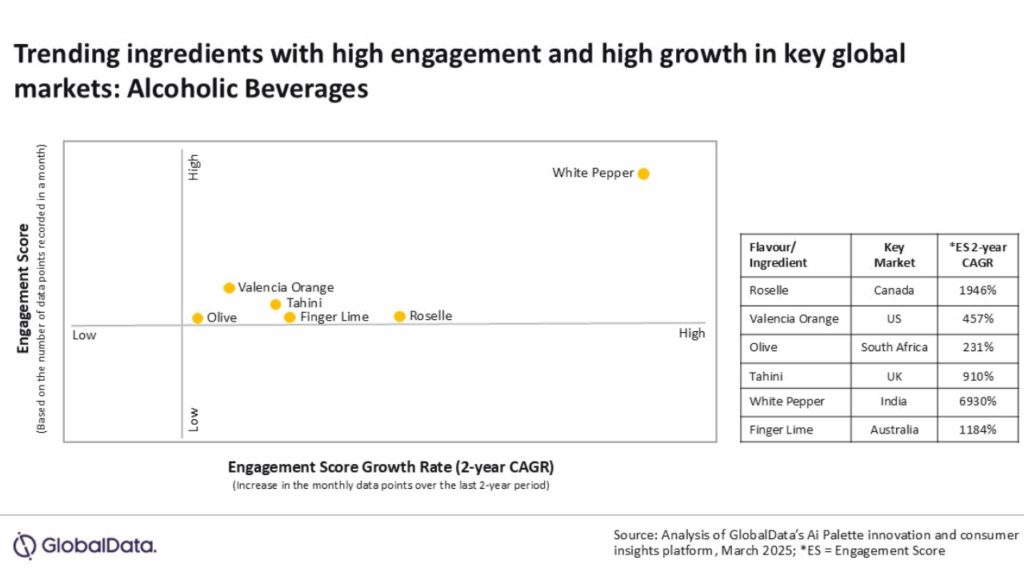Six Emerging Alcoholic Beverage Flavors in 2025, According to AI Insights

Summary
AI-driven insights from GlobalData and Ai Palette have identified six emerging ingredients—tahini, roselle, Valencia orange, olive, white pepper, and finger lime—set to shape the future of alcoholic beverages in 2025. Chosen for their strong consumer engagement and growth potential across key markets, these flavors reflect shifting preferences toward health, novelty, and cross-generational appeal. Amid rising global challenges, such ingredient innovation offers a path for brands to attract Gen Z and health-conscious consumers while staying competitive in a transforming drinks landscape.
Artificial Intelligence (AI) is transforming how we understand consumer behavior—and when it comes to predicting flavor trends in food and beverage, it’s becoming an indispensable tool. GlobalData, a leading analytics and consulting firm, recently partnered with AI Palette to uncover the top six high-potential ingredients shaping the future of alcoholic beverages in 2025. The findings, published in the report Emerging Flavors & Ingredients in Alcoholic Beverages, highlight how innovation and health-conscious preferences are redefining the global drinks landscape.
How the Analysis Works
Leveraging AI Palette’s Foresight Engine, the research drew from a database of over 61 billion real-time data points spanning social media, e-commerce platforms, and foodservice menus. The goal? To identify ingredients showing both high consumer engagement and strong growth potential across six key global markets. Each ingredient was categorized based on its flavor profile, pairing potential, and functional benefits—offering beverage developers strategic guidance for product innovation.

1. Tahini
Primary Market: United Kingdom
Flavor Profile: Nutty, Woody, Bitter
Pairings: Chocolate, Tangerine, Honey
Benefits: Nutritional density, creamy mouthfeel, neutral coloring
Traditionally used in Middle Eastern cuisine, tahini—made from ground sesame seeds—is finding a new home in alcoholic beverages, particularly in the UK’s fast-growing stout segment. Craft brewers are beginning to experiment with tahini’s rich texture and subtly bitter flavor. One example: Rogue Ales & Spirits' limited-edition stout infused with tahini, launched in partnership with Honey Mama’s.
2. Roselle (Hibiscus sabdariffa)
Primary Markets: Middle East & Africa, Asia-Pacific
Flavor Profile: Floral, Fruity, Herbal
Pairings: Lime, Lemon, Ginger
Benefits: Antioxidants, digestive support, vibrant color
Roselle, widely known for its use in herbal teas and tonics, is making waves in the spirits category. Its tart floral notes appeal especially to younger consumers and health-conscious drinkers. In Asia-Pacific markets, it ranks among the top five trending flavors in alcoholic beverages.
3. Valencia Orange
Primary Market: United States
Flavor Profile: Tangy, Sweet, Bitter
Pairings: Cranberry, Honey, Vanilla
Benefits: Vitamin C content, regional authenticity, sensory versatility
This summer citrus variety is seeing increased usage in wines, beers, and ciders across the U.S., where sweet flavor profiles dominate. Valencia orange offers a familiar yet dynamic twist, aligning with consumer preferences for natural fruit infusions.
4. Olive
Primary Market: South Africa
Flavor Profile: Bitter, Nutty, Earthy
Pairings: Rosemary, Orange, Lemon
Benefits: Heart-healthy fats, natural appeal, digestive benefits
Long a staple in Mediterranean cuisine, olives are now being explored as a bold new direction in cocktail and spirits formulations. Their savory, umami-driven notes offer depth and a health halo, tapping into South Africa’s rising demand for “clean-label” beverage experiences.
5. White Pepper
Primary Markets: MENA, Asia-Pacific
Flavor Profile: Earthy, Fiery, Woody
Pairings: Peach, Caramel, Agave
Benefits: Anti-inflammatory, balances sweetness, subtle complexity
Unlike other ingredients, white pepper is often used more for its conceptual taste notes than as a direct infusion. Its spicy, warming undertones enhance the flavor complexity of both clear and aged spirits—appealing to consumers seeking premium and artisanal drinking experiences.
6. Finger Lime
Primary Markets: Australia, UK
Flavor Profile: Citrus, Floral, Bitter
Pairings: Peach, Vanilla, Agave
Benefits: Unique texture, high visual appeal, premium positioning
Native to Australia, finger lime is gaining momentum in the gin and vodka categories. Known for its caviar-like pulp and bold citrus burst, it aligns with growing interest in visually striking, experiential drinks—especially in upscale bars and at-home mixology.
What This Means for the Industry

“The alcoholic drinks sector is facing complex challenges,” said Alice Popple-Connelly, Consumer Analyst at GlobalData. “From the global push toward lower alcohol consumption to increasing tariffs on imports, the pressure to innovate is greater than ever.”
These six ingredients offer brands the chance to create standout products that appeal to health-conscious, adventurous, and younger consumers—particularly Gen Z, who prioritize both functionality and uniqueness in their beverage choices.
“By leveraging emerging flavors and conceptual ingredients, alcohol brands can reinvigorate their core offerings and enter new market segments with confidence,” Popple-Connelly added.
Why Innovation Matters – A View from Nam Viet Group
As a leading manufacturer and exporter of functional beverages to over 200 countries, Nam Viet Group welcomes these evolving global trends. With expertise in fruit-based and plant-based drink innovation, the company sees opportunities to incorporate emerging ingredients like roselle, finger lime, and Valencia orange into future product lines—not only in juices but also in potential low-alcohol and fermented drinks.
Backed by over 40 internationally certified production lines and a global reputation for quality and innovation, Nam Viet Group continues to position itself at the intersection of health, taste, and sustainable growth.
Source: Craft Brewing Business
